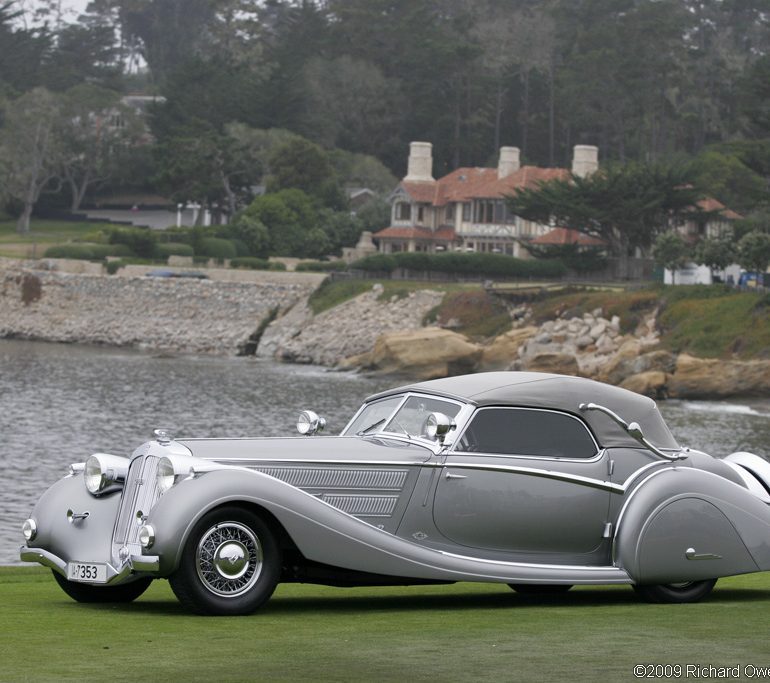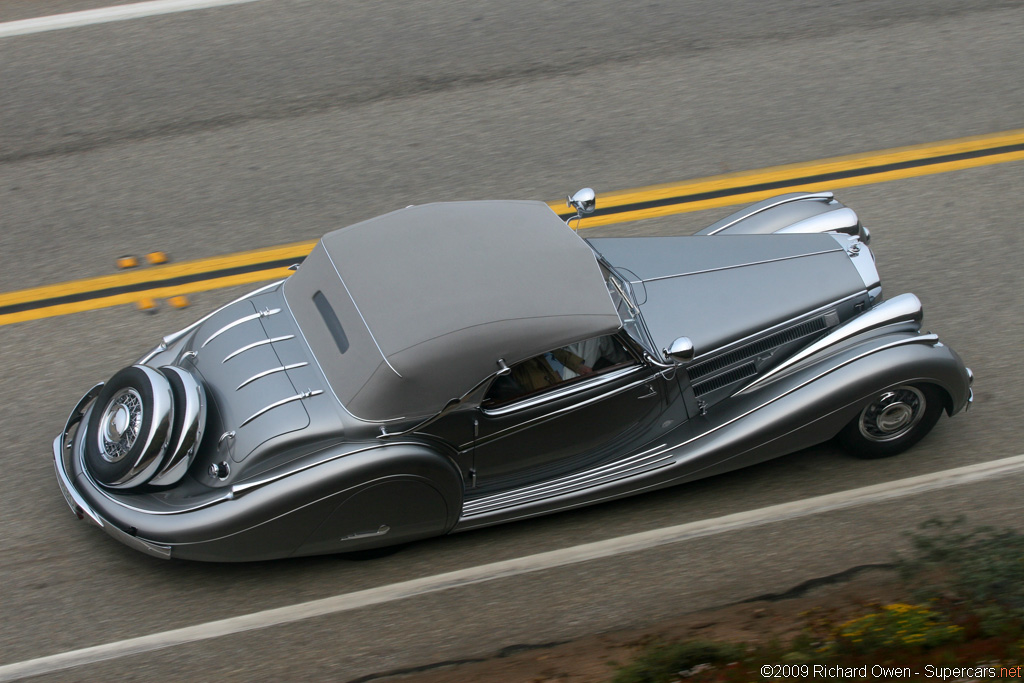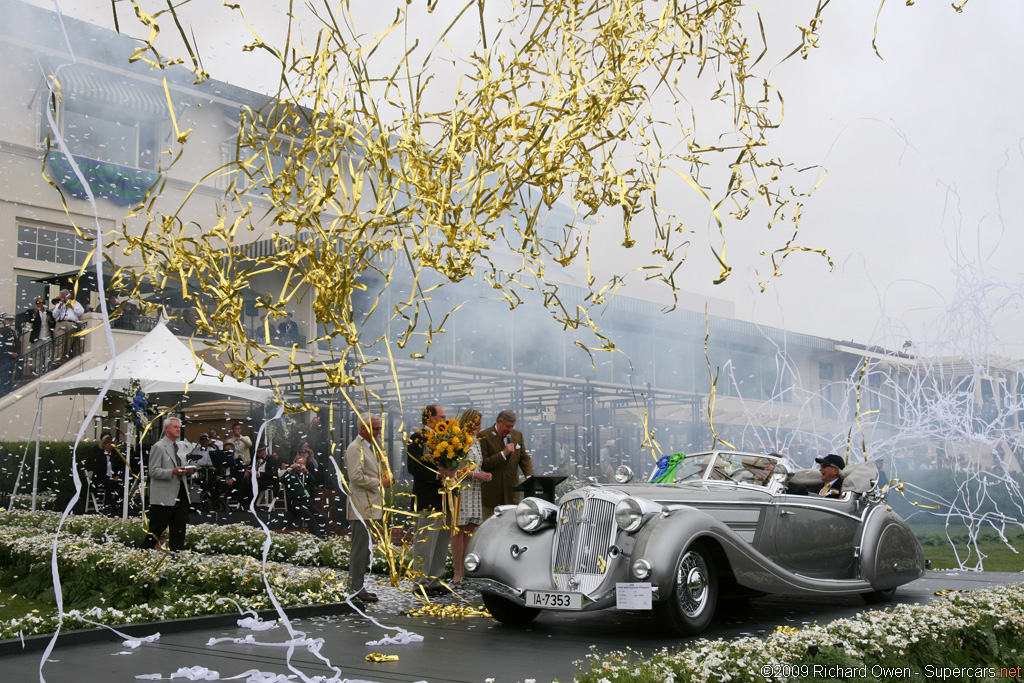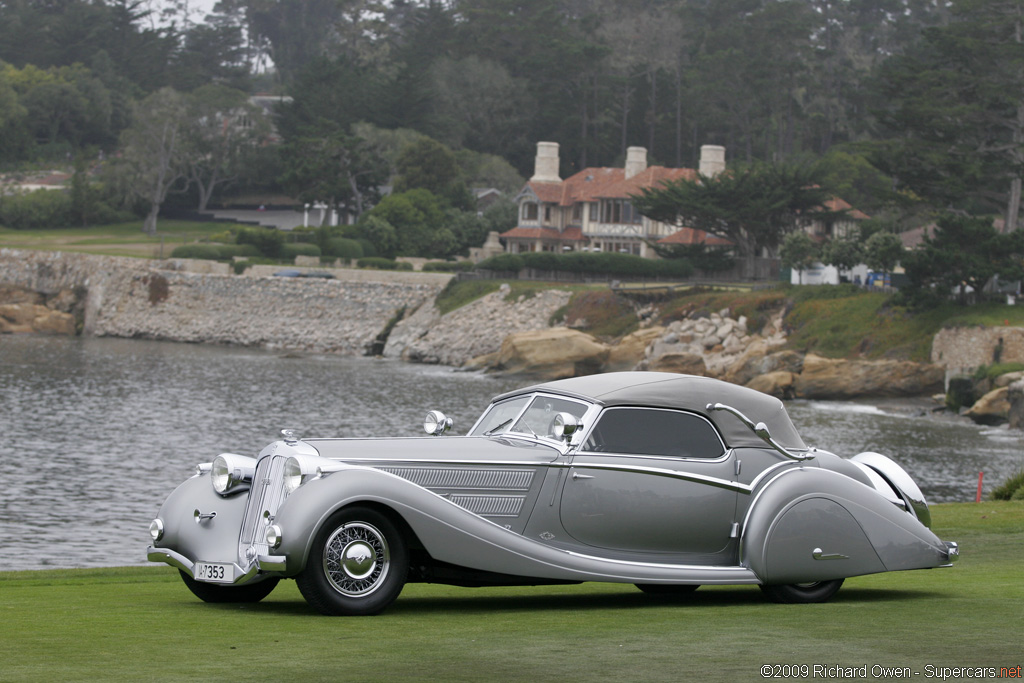1937 Horch 853A Spezialcabriolet
There’s no question that Germany was at the forefront of automotive engineering in the 1930s. Ferdinand Porsche launched the seminal Volkswagen Beetle while Mercedes-Benz and Auto Union were dominating Grand Prix racing. Furthermore, companies like Horch and Mercedes-Benz were producing luxury cars that challenged the rest of the world with their advanced aerodynamic design. Such is the case with our 1938 Horch. It was intricately crafted by Voll & Ruhrbeck of Berlin and can currently be considered their most elegant design.
Germany was the very first country to produce a streamlined coupe. The Mercedes-Benz 500K Autobahnkurier of 1934 caused a sensation at the Berlin Motor Show and motivated Ettore Bugatti to go back to Molshiem and design his Type 57S Aérolithe. Both these cars were influenced by aviation design and the functional beauty of the aerofoil. Not long afterwards Italian, French and American designers caught onto this trend. In fact, many of the French curves were drafted with the German-sourced Burmester set of tools from 1904.
By the time this Horch was completed in 1937, the streamlined era had given car curves and transformed them from the staid designs of previous eras into voluptuous forms. This was especially true of the show cars from the period which took the idea to its extreme. The best example of this is Figoni et Falaschi’s ‘Goutte d’Eau’ which was devoid of any straight lines. Typically these cars were designed for a Concours d’Elegance of the era which celebrated both automotive styling and fashion during opulent garden parties. Since these were typically events for the elite society, the chassis and running gear came from the best manufacturers in Europe.
In the same group that included Mercedes-Benz, Alfa Romeo, Talbot-Lago and Delahaye was Horch. This company dates back to 1899 when August Horch first started repairing and building cars under the banner Horch & Co. Into the thirties, engineer Franz Fiedler designed a range of straight eight engines and an even rarer V12. Both were capable to power large or even armored bodies which would appeal to the upper end of the market. By 1932, Horch was combined with DKW, Wanderer and Audi to form Auto Union. This left Horch as a luxury wing of the Saxony cooperative.
Under the Auto Union banner, Horch redesigned their eight cylinder cars and offered the 850 series as a response to the best from Mercedes-Benz. The 853A variant had a more powerful 120 bhp engine, independently spring suspension and a long wheelbase of 127 inches. Naturally, this was the choice for Horch’s best factory coachwork and they offered a range of bodies including the Sport Cabriolet with its sweeping fenders and signature front grill. Companies like Glasser, Erdmann & Rossi and Voll & Ruhrbeck would all create variations on this theme.
Horch had a large presence at the 1935 Berlin Motor Show which was opened by Adolf Hitler and his party leaders. Many were taken in by the large Horchs on display and our feature car may have been produced with funds from the the Third Reich. Fighter pilot and Nazi leader Hermann Göring owned several Horch cabriolets which had similar style to the Sport Cabriolet, but the Voll & Ruhrbeck design was unique.
Design
Our feature cabriolet is similar in profile to the Sport Cabriolet first developed by the Horch factory, but is completely different in detail. It uses teardrop shapes to good effect, including front headlight cowls that extend down the broad fenders. Tidy chrome accents run the length of the fenders, integrating into the running boards and concealing the driving lights. These are complemented by an accent dash that was the signature touch by French coachbuilders Figoni et Falschi.
At the rear are two spare tires neatly tucked into the rear cowl. This design was later copied by Henry Ford. During a trip to Europe he discovered the rear-mounted spare tire and when back to America to equip his 1939 Lincoln Continental with a similar luxury. Unfortunately, this cut-off access to the trunk and forced the lid to be smaller and in an inconvenient location.
Inside the Horch space for four people. Large suicide doors reveal an intricate wooden dashboard with burled walnut veneer and Horch’s standard altimeter. The woodwork extends to the doors with bakelite knobs and integrated armrests.
History
Chassis 853558 is our feature car and its history remains somewhat of a mystery. The onset of war and allied bombing destroyed the Voll & Ruhrbeck factory in Berlin-Charlottenburg, leaving little in the way of ownership history or the original documentation. Fortunately, the car survived the chaos and was seized by the French government. A picture exists of the cabriolet with General Jean de Lattre de Tassigny, head of France’s first army.
In the post-war era, the Horch was relocated to Switzerland and spend some time their before being offered by the Oldtimer Garage of Berne and selling to Dr herbert W Boyer in San Franciso. Painted black it was displayed at the 1988 Pebble Beach Concours d’Elegance where its next owner, Robert M. Lee of Nevada first laid eyes on it.
In restored condition, the car was bought by Robert Lee for inclusion into his impressive collection in Nevada, USA. In 1997 he acquired the car and displayed it at the 1999 Pebble Beach Concours to complement the Horch Anniversary class. During this time he also had his foundation, RML Trust, search for the car’s history including the original date of manufacture. They wrote Rudolf Voll who worked at his uncle’s workshop but no information was available. Fortunately several original vintage photographs were sourced and used a reference for complete restoration.
Restoration
By 2006, work began on the Horch. RML Trust used the available photographs to bring the car back to original specification. This including fabricating both the front and rear bumpers which were missing their license plate holders. Furthermore, it was decided to change the car to a hue of metallic grey first offered by Horch. This was a modern homage to the iridescent paint first offered by Horch as an option that used fish scales in the lacquer paint to make it shimmer.
During the restoration almost all the body panels were retained. Only the hood needed to be fabricated with its twin rows of louvres. It took the foundation 2.5 years to complete the car details such as the intricate interior woodwork, Spinneybeck leather upholstery and chrome plating taking considerable work.
When completed, the Robert Lee chose to have his car first displayed at the Pebble Beach Tour d’Elegance were it ran flawlessly a couple days before the show. With 150 miles completed, it was subsequently displayed at Concours d’Elegance where became an easy choice for Best of Show.
Story by Richard Owen
1937→1940 Horch 853A Sportroadster
See full 1937→1940 Horch 853A Sportroadster here
In Detail
| submitted by | admin |
| type | Series Production Car |
| built at | Berlin, Germany |
| body stylist | Voll & Ruhrbeck |
| production | 1 |
| engine | Type T850 Straight 8 |
| position | Front Longitudinal |
| aspiration | Natural |
| valvetrain | SOHC, 2 Valves per Cyl |
| fuel feed | Updraft Solex 35 JFF Carburetor |
| displacement | 4944 cc / 301.70 in³ |
| bore | 84 mm / 3.3 in |
| stroke | 104 mm / 4.1 in |
| power | 89.5 kw / 120 bhp @ 3600 rpm |
| specific output | 24.27 bhp per litre |
| body / frame | Steel Body over Steel Frame |
| driven wheels | RWD |
| front brakes | Hydraulic Drums w/Vacuum Assist |
| rear brakes | Hydraulic Drums w/Vacuum Assist |
| f suspension | Upper A-Arms w/Lower Transverse Leaf Springs, Hydraulic Shock Absorbers |
| r suspension | de Dion Tube Axle w/Semi-Elliptic Leaf Springs, Hydraulic Shock Absorbers |
| transmission | 4 Speed Sliding Gear w/Overdrive |







